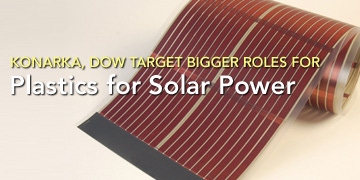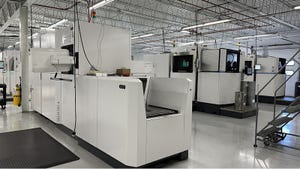February 7, 2009

FlowerPower fueled the 1960s. Now get ready for Plastics Power.
Third-generationsolar technologies use advanced materials, including conductive plastic, toachieve acceptable efficiencies and design capabilities not possible withsilicon.
Two of thecornerstone programs in the federal Solar AmericaInitiative (SAI) are building-integrated organic photovoltaic technologiesbeing developed by Konarka, of Lowell, MA and Dow Chemical of Midland,MI. Electricity from the grid costs abut 8 cents per kWh now. Power from currently available solartechnology is triple that. The SAI wants its projects to deliver grid power forless than 10 cents per kWh by 2015.
One novel but pricey application is a sun umbrella fitted with flexible solar panelsthat provide electricity on the spot for laptop computers, cell phones or otherconsumer applications. They're already being used on outdoor patios of coffeeshops in sunny locations and on patios near swimming pools.
"Thesefirst units are selling for $10,000," says Joe McKenna, executive vicepresident of SkyShades of Longwood, FL."I hope to drive the price down to $7,500-$8,000 as volume increases;the first few are always a bit more expensive. Our umbrella units on their ownsell for $5,200 as they are a structure and must be anchored to a suitablefoundation."
Theelectricity in the flexible solar panels comes from Power Plastic, a patentedand highly secretive material. A review of Konarka patents shows that much ofits work has focused on conjugated polymers that behave as metallic conductors andsemiconductors. The polymers include at least the following: polythiophenes, polyalkylthiophene,polydihexylterthiophene (PDHTT), polythienylene vinylenes and polyfluorenederivatives.
Photovoltaiccells are produced using continuous web manufacturing techniques in which apolymeric system is applied in a tree-like geometry to a substrate and subsequently in a roll-to-roll type manufacturing process.The substrate is any plastic that can be metalized in a web process. Onepreferred material is polyester. Othercandidates include polycarbonate, acrylic and polystyrene. Efficiency can beimproved through application of a coating that will prevent the reflection of certain types of light. Someproducers also further enhance performance through doping with conductivematerials. The photovoltaic cells can also be applied through other printing systems.
"Konarka'sinnovations lie within its materials, manufacturing processes and form factorfor its light-activated power plastic," says Dan Williams, vice president ofbusiness development at Konarka. "We've brought proven coating and printingknow-how from the chemical, photographic film and flexible electronicsindustries to energy via a new class of nano-structured materials."
Konarka'smaterial is two-thirds less expensive than traditional silicon-based solarmaterials. It's also very light – only one to two ounces per square foot. Konarkarecently announced a new strategic collaboration with Total, a major oilcompany based in Paris.Total is investing $45 million in Konarka, becoming its biggest shareholder. Total clearly sees some synergies with itsbusinesses, which include Cook Composites and Polymers, which develops printinginks as well as other compounds.
The currentdemonstrated efficiency of the system is 6 percent – good but not really goodenough. Typical silicon-based solar systems have efficiencies of around 15percent. Konarka says itselectrical output will cost less than 10 cents per kWh, making itsmaterial ideal for widespread use as a building-integrated photovoltaic.
Aspreviously reportedby Design News, another major player in this technology arena is Plextronics, aPittsburgh-based spinoff from Carnegie Mellon Universitythat opened its first manufacturing development line in January.
The small-scale manufacturing facility will printsolar demonstration modules with printable solar inks made from conductivepolymers, such as those used by Konarka. The modular design of the line willalso permit the company to evaluate new processes that will maximize theperformance of those inks.
"This line is focused on stimulatingbroad market commercialization of our innovative ink systems," says AndyHannah, Plextronics' President and CEO."Sometimes, especially in an emerging market like printedelectronics, a company must be willing to take the initial steps to demonstrateto the marketplace what's possible with new technology."
Plextronicsuses conductive polymer technology developed by Dr. Richard McCullough of Carnegie Mellon University.
Dow Chemical's Role
Anothermajor player is DowChemical, which is receiving $20 million from the Solar America InitiativePathways Program conducted by the U.S. Department of Energy.
Dow isleveraging its encapsulation and roofing knowledge to develop solar roofingshingles. Late last year, Dow installed a 1,350-ton tandem clamp injectionmolding machine at its Michigan Operations manufacturing site in Midland, MIto develop technology that will integrate flexible solar panels into plasticroofing.
Currentsilicon-based solar cells are packaged within heavy glass panels on rooftops.They are expensive, hard to install and produce electricity that is significantlymore expensive than electricity sold over the grid.
"Dow'sinnovative technology is based on a much more cost-effective photovoltaicmaterial called CIGS and these cells are ‘packaged' within the roofingproduct creating a ‘solar shingle,'" says Bob Cleereman, Sow's senior technicaldirector of building-integrated photovoltaic technology.
CIGS, whichis composed of copper, indium, gallium and selenium, is used as light absorbermaterial for thin-film solar cells. More than two dozen companies are workingwith CIGS technology, and some are struggling to achieve workable efficiencylevels.
Dow's original partner in the SAI project was a California-based company calledMiasloe, which at one time had been a leader in CIGS development. But the company missed key objectives and wasreplaced in the SAI project last year with Global Solar Energy, which last year opened a CIGS factory in Arizona.The company expects to produce 20 megawatts of the film at the plant this year.
"We arecollaborating with Global Solar Energy because throughout our search for asolar material provider, it was the only company able to supply a qualifyingflexible CIGS material that meets our needs and the requirements of the SAI,"said Dow's Cleereman. "Copper Indium Gallium diSelenide has proven to be the most efficient,cost-effective thin-film technology for building-integrated photovoltaic applications."
Global Solar is the onlycompany in full-scale production of CIGS cells on flexible substrates and hasachieved a record-setting average 10-percent solar cell efficiency, arequirement for the SAI program. The goal of the SAI is to create solarelectricity cost effectiveness with grid electricity within six years.
Dow wouldnot discuss specifics of its technology, but the giant injection moldingmachine is a big clue. Dow may try to integrate the solar panels into a moldedplastic structure, just the way a label is molded into a dashboard inside amold cavity. It's an exciting idea if the solar material can be web-fed intothe tool. That creates very high-volume production economics.
It's notclear what thermoplastic materials may provide the structure for the"molded-in" solar panel. One candidate is thermoplastic olefin, which is amajor material in the roofing business (Stevens Roofing Systems and GeomembraneSystems) that Dow acquired last year. Although Dow has been trying to reduce itsprofile in volume thermoplastics, it remains a major producer of TPO, which isalso widely used in automotive applications.
The Konarkaproject is very interesting as a leading edge technology, but the Dow projecthas the promise to be a major game-changer in the not-too distant future.
About the Author(s)
You May Also Like





